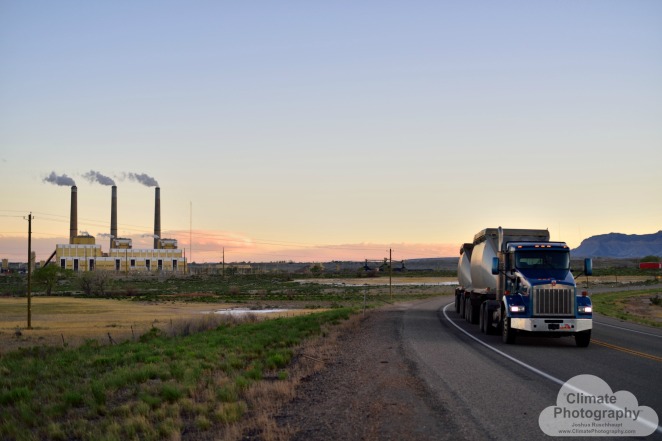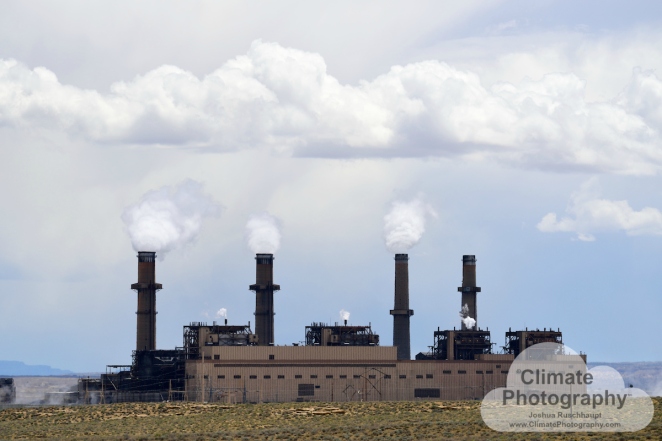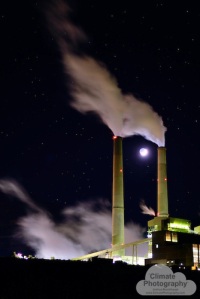
The public, yet somehow photo-banned, turnout facing the PacifiCorp Huntington Power Plant, along Utah Highway 31.
In one 24 hour period in May 2016, across two western states and over 650 miles, I saw three coal-fired power plants, one hydroelectric dam, a massive new solar farm project, and a unique solar plane called the Solar Impulse 2 that was on its way to completing a ’round-the-world trip without fuel for the first time in human history. And I was driving an extended range electric vehicle, or EREV, the Chevy Volt. Now that’s a whirlwind energy tourism tour.
Granted, I wasn’t stopping to charge my EREV every EPA battery capacity rated 38 miles, but relying on the “extended range” technology that allows gasoline to generate electricity for the batteries. Driving an electric vehicle across the country is comfortable and fun in a Volt, though I’m hopeful for the day when I’ll be fast-charging instead of refueling the battery. But whereas some people use the Volt for 100% electric miles and only locally as a commuter car, I use the full design of the vehicle, and drive thousands of miles on single trips, as well as my local daily commute.
I began my day at sunrise at the Huntington coal-fired power plant, near Huntington, Utah, where I was visited by security who was curious about my photography. This was a marked difference in behavior for security of the power plant, which had been attempting to stop me the previous day from photographing their properties. Having left all that needless drama behind, I was making my way southwest to reach the Red Hills Renewables Park, near Parowan, UT, which made me feel much more optimistic for my day.
But before reaching my destination, and while stopping for one of those gas station breaks where I needed the food and facilities more than my high mpg car needed the fuel, I checked my email and noticed that one was from the Solar Impulse 2 team, notifying me via broadcast newsletter that they were launching for their next leg from Phoenix, AZ that night!
I calculated my luck, my odds of reaching it in time, and my plans for the day. Could I drive over 500 miles and still hit my two pre-planned cross-country photo-targets I wanted? In under 13 hours? Google maps revealed it was a 10 hour drive. “Well hell… that gives me three hours of ‘play’ time,” I remember thinking. I’d have to drive without a wink of sleep, and arrive in the middle of the night, but I’ve put myself through worse driving conditions before. And it’s a once-in-a-lifetime chance to see a history-making event… why not go?! I definitely felt that I would regret not at least making the effort. I decided to do the full whirlwind tour: photograph a sea of mid-day solar panels in Parowan, then scream down southeast to Page, AZ to photograph the highly polluting Navajo Generating Station, as well as Lake Powell and Glen Canyon Dam if I could get there before dark, then bee-line it straight south to the Goodyear Airport in Phoenix to see the Solar Impulse 2.
I was worried I would drive the entire way there, be turned away at the entrance and not get to see the plane take off, so I contacted their media team via email. Through a back-and-forth over email, I wasn’t given any assurance that I’d be given the required RSVP credentials to enter. What the hell… go anyway, I told myself. Once-in-a-lifetime, I told myself. 600 miles and 13 hours of driving and photography to go… sounds like an adventure!

Red Hills Renewable Energy Park, Parowan, UT, looking north, just a small portion of the entire 630 acres array.
First stop: at Little Salt Lake, near Parowan, UT, there is a 104 MW photovoltaic (PV) solar array called the Red Hills Renewable Energy Park, owned by Scatec Solar and just six months old, having been completed in December, 2015. To that point, it was the largest solar panel array I’d seen. Very impressive at over 600 acres! I was wishing that I had a drone camera to capture this massive spread across a portion of this valley, but lacking such, decided that the nearby rising hillside might provide a similar effect at a distance. After abandoning my position fence-side and climbing onto the sides of my car to photograph the array without the fence in my frame, I gained some elevation south of the Park and was again impressed with this project’s size. Certain lenses, even at this distance, couldn’t capture its breadth!

Dr. Frankenstein’s backyard. A vision of 104 MW of electrons funneled from 340,000 solar panels across 630 acres through these wires at the Red Hills Renewable Energy Park, supplying energy for 18,500 households.
I also noticed it had it’s own substation that tied into one of the three cross-continental transmission lines skirting the project’s western edge. Some of this infrastructure makes for interesting shapes and subjects to photograph. One piece of the substation looks like a 1950’s vision of futuristic technology as a round sphere with spikes of wires exiting in different directions. I have no idea what its function is, but it looks big, powerful, and cool. And dangerous.
Okay… without property access and nobody immediately available to ask, plus a deadline, I decided to scoot (“shoot and scoot” being the theme for this day). Hitting the road for Page without the ability to stop at a photographer’s whim was kind of painful with all kinds of mountain, canyon, and valley scenery flying-by. But the payoff was on the approach to Page, across the red rock and desert valley, as the western sun began receding through the layers of Navajo Generating Station smog… everything was turning red… and the red rocks really start glowing when bathed in red light, and I was drenched in photographer’s golden hour awe bliss.
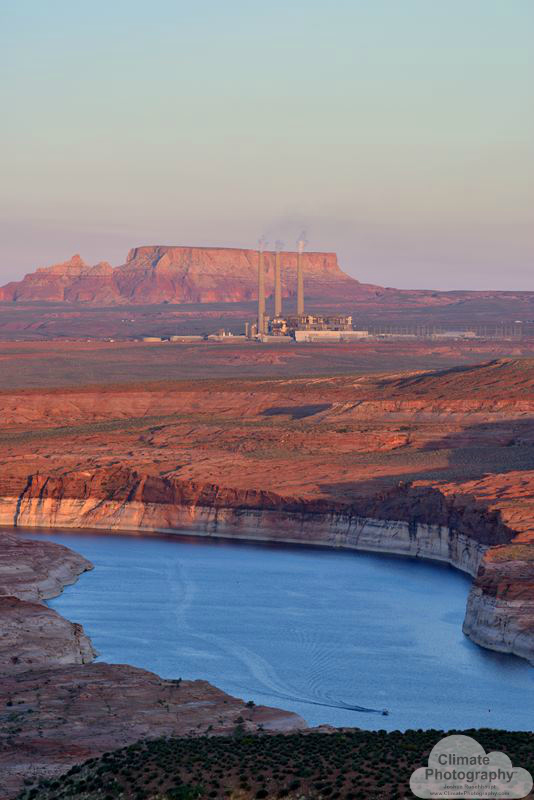
The Navajo Generating Station (Salt River Project), near Page, UT. This 2,250 MW power plant provides power across the west, including making water run uphill through the Central Arizona Project. This plant is the single-largest emitter of carbon dioxide in America and currently permitted to run through 2044. Lake Powell, in the foreground, allows flatwater recreation and adds more power through the 1,320 MW Glen Canyon Dam.
But I didn’t have time to scout my locations, prioritize shots, or anything! Thinking fast, I decided this would have to be a swoop-through shoot. Stop at a distance on approach for the grand scene… shoot… scoot… get closer for a mid-valley scene at a tourist trap of a rest stop with an elevated view of Lake Powell with the power station in the distance… super-telephoto to pull in that plant in the distance with the water in the foreground, and soaked in red rocks and red sunset at its height… quick lens change for wide-angle to grab the entire scene, and all that wafting smog… scoot… drive to the Glen Canyon Dam… quickly determine I want several angles of shots, and do a couple of shoots on both sides of the bridge as the sunset waned… scoot… no time to drive closer to the power plant… gotta close the gap between Page and Phoenix through the dark… damn… can’t see the gorgeous red rocks along the way on this trip. The glorious Navajo landscape fades, and I’m left imagining what I’m passing from prior trip memories.

Dam blocking the river (rt), reservoir generating methane from decomposition (center, bottom), coal-fired Navajo Generating Station (center) polluting the visible sky with multiple emissions including carbon dioxide in massive amounts, coloring the sky with a technicolor sunset among red rock cliffs and a sagebrush sea. Hauntingly beautiful. This is a similar vision to “The Scream.”
Stopping in Flagstaff for some much needed food and a break was refreshing. I needed that, because I was really beginning to feel the miles, the darkness, and my sagging eyelids. …on the road again… desirous of stopping at certain places for some spectacular astrophotography… damn… next time… fight the head-nodding sleep enemy with some boisterous loud music and road food… but I was also energized for what I was about to witness in a few hours.
I arrived in Phoenix somewhere between midnight and 1 am, and I managed to identify where the party was held at the airport. I began seeing local T.V. news satellite trucks and people converging on one building as I approached, and upon entering, there was someone checking for tickets haphazardly as people flowed in without lines or order… I said I didn’t have one, and he let me through anyway… whew… glad I took the chance!
The plane was out of the hangar and on full display with the pilot, Bertrand Piccard, in the pilot’s seat already. I discovered by talking with a few people in the crowd that the speeches were already done (damn, missed that), and they were prepping for take-off. But I still had a two-hour wait for that to happen. At this point, I was a bit delirious from so much driving and an early morning rise, but the energy of the crowd and the alertness of the seemingly dozens of workers kept me wakeful.
In hindsight, I wasn’t at the top of my game with regard to making great images in tough photographic conditions: artificial bronze-colored light at night with variable speeds of motion from people and the plane… widest aperture!… increase shutter speed!… who cares about white balance-figure that out later in post!… maximum ISO!… better to have higher noise than to make a bad shot with motion-blur!… test shot… adjust… test shot… my brain was shouting orders to my fingers that didn’t want to follow through with the camera in all cases because several of my shots, upon later inspection, aren’t to my usual exacting standards, and for the flight itself, there was no re-do, meaning planning ahead was necessary while waiting for go-time. I decided to start with the 50mm for the runway shots during take-off, then switch to the 200-500mm for lofty distance shots. And, at 3 am, after being awake and driving over 650 miles over 20+ waking hours, I think I even had trouble with making sure I was getting a decent focus. Or maybe my bleary eyes thought it was focused when later they didn’t all come out as great as I normally want.
So I was a bit disappointed with my photographic results, but I was definitely thrilled with simply having made it there in one piece and not having driven off the road somewhere along the way. I was witnessing history in the making.
Then, when you would have expected the crowd to shout cheers and a raucous calamity of celebration when the plane lifted off the runway, still at a distance not too short from the starting point, we were all silently transfixed! Nobody had ever seen such a thing before! It had the speed of a Wright Brother’s plane! Incredible.



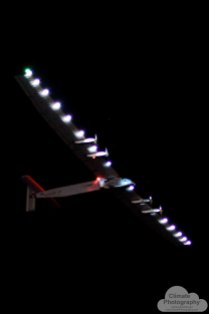






(Click on images above for full captions and large size view. Note that these are low-res images, which degrades the image quality. For higher-resolution images, see www.climatephotography.com.)
The experience of getting to see this experimental plane, lifting off the runway like a breath-lifted feather in the light desert warm air, silently gliding, almost hovering overhead, with a comparatively wide 747 anchored on the runway underneath, I was amazed at this feat. This plane, carrying a single pilot, with a massively wide wingspan and seemingly heavy by the way multiple people man-handled it while manually taxiing down the runway, was simply floating aloft up there, making slow, wide circles to gain altitude before meandering eastward into the darkness.
Andre Borschberg states “To build an airplane of the size of a 747 with the weight of a car, something which was considered impossible by the aviation industry, we had to develop the right mindset in order to push the limits of the technologies.” That includes, by the way, propulsion power equivalent to a couple of blow dryers to circumnavigate the globe. If this is starting to sound a bit like that MacGuyver episode where he built a plane out of bamboo and garbage bags, you wouldn’t be far off from the creativity of these guys. However, imagine MacGuyver with a massive budget, and access to the entire planet’s best technology to create this plane.
Fully charged, this plane’s batteries stored enough energy to fly at night, making enough room for the electrons to be refilled by the solar cells spread across the back of the massive, slender wings to refill by the next nightfall. The propellers were very quiet. In fact, I couldn’t even hear them beating the air. That must have meant a low-friction, high efficiency. What I did hear was what you might expect from an electric vehicle… you can even hear it faintly in my EREV/Volt… a faint electric whir. Unmistakable, I heard it overhead.
This is history I’m witnessing, I thought at the time. And it was. A convergence of multiple clean, lightweight technologies and the spirit of human adventure of these two pilots, Bertrand Piccard, flying overhead, and Andre Borschberg, sharing the flying load in back-to-back legs across this planet of ours. What does the future hold, I wondered? Will we all be flying in battery-charged, solar planes someday?
This is history in the making in another way… the birth of a climate solution. What scale in aviation might these technologies achieve? Next, we’ll see solar unmanned drones by Facebook beaming WiFi to entire continents while staying aloft for months at a time, already in test flights. Or Airbus’ Zephyr drones. Or Google’s balloons. I look forward to the Solar Impulse team’s future projects, already being planned.
This exhibition had completely enchanted the crowd of a couple hundred admirers, from children accompanied by parents, to paparazzi, to grandparents in wheelchairs. We were all mesmerized at the graceful and vaguely manta ray-esque front profile of this flying wonder’s departure. Its etherealness was enhanced by the backdrop of a star-studded night sky, twinkling up there, seemingly beckoning this quiet solar wing of humanity’s Icarusian whim and audaciousness. But whereas Icarus’ wing wax melted and weakened from the sun, the Solar Impulse 2 wings soak in the warm photons and are strengthened.
That flight would end over 18 hours later, as planned, in Tulsa, OK. Later, the round-the-world journey would end in Abu Dhabi, UAE, on July 26, 2016.
How far we’ve come, from digging out rocks and burning them for heat, to capturing electrons from the sky, and using them to fly. And yet, I had just witnessed, in a single day, our guarded grip of a trusted and faithful coal-fired legacy, only to be amazed at the birth of new and innovative applications of existing technology. The #futureisclean.
To view all related galleries for this whirlwind energy technology tour, see the Western States Energy Infrastructure set of galleries at Climate Photography. Prints and downloads are available.



